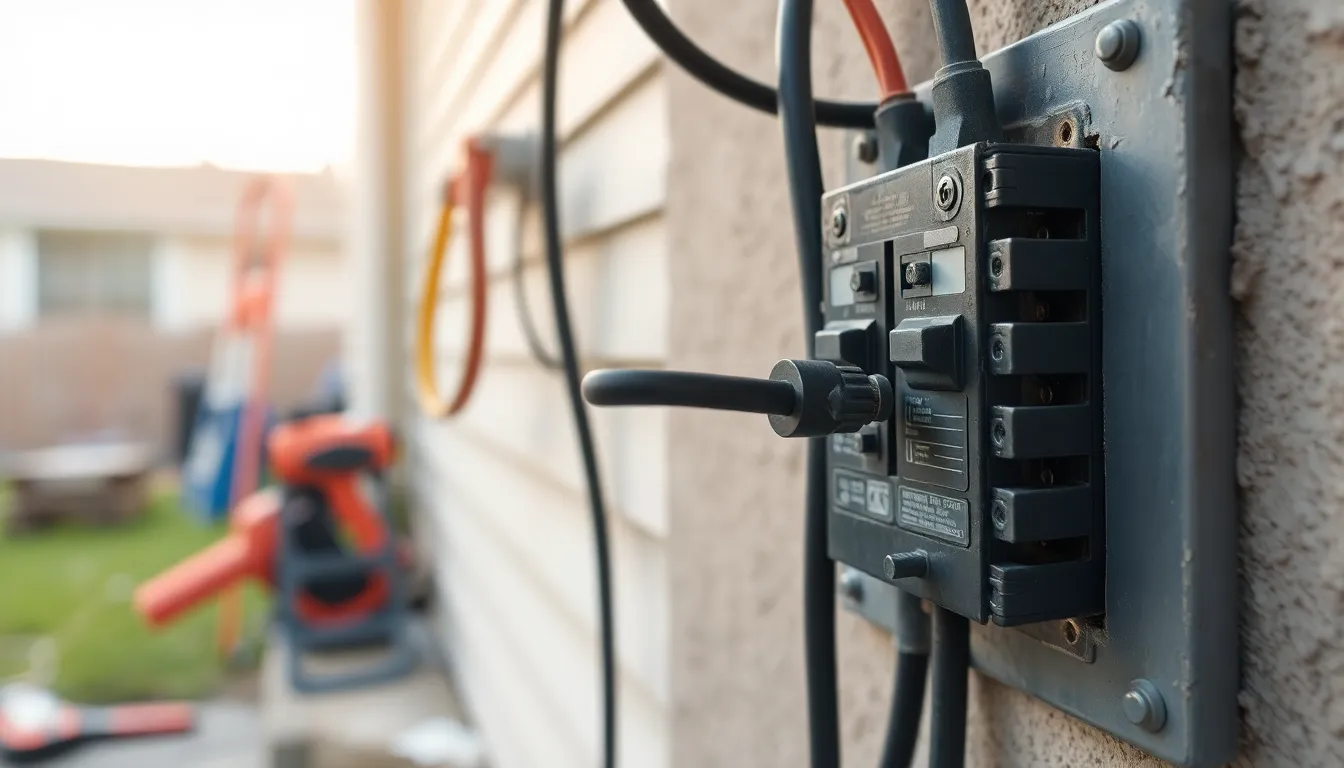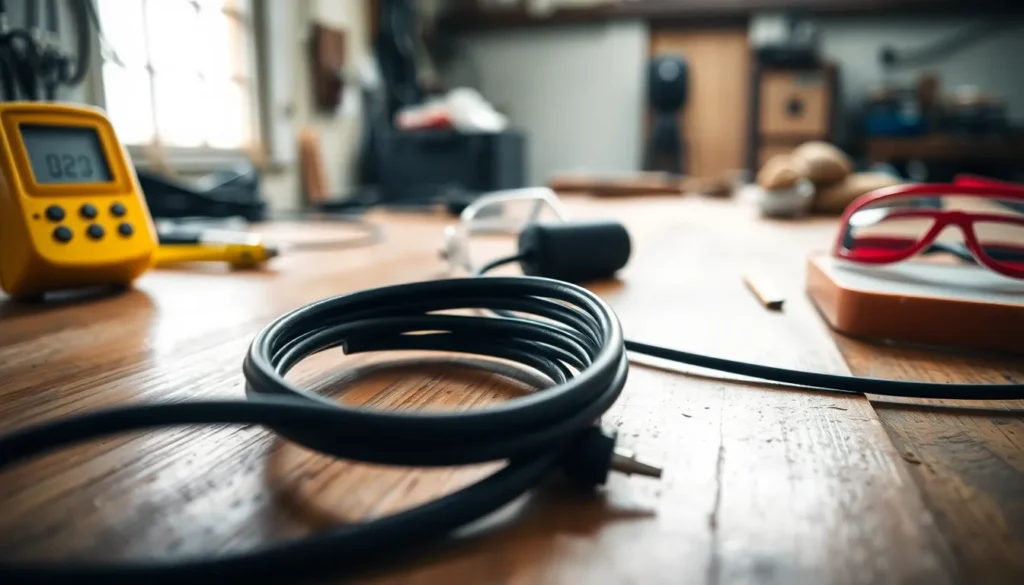When it comes to wiring, confusion can spark faster than a faulty circuit. Many wonder whether the black wire or the white wire is the hot one, and let’s face it, nobody wants to play a game of “guess which wire will give you a jolt.” Understanding this distinction isn’t just for electricians; it’s essential for anyone who’s ever thought about tackling a DIY project or simply wants to avoid a shocking surprise.
Table of Contents
ToggleUnderstanding Electrical Wiring
Understanding electrical wiring is crucial for safety and proper installation. Black wires typically carry hot current, while white wires serve as neutral. In most wiring systems, these designations hold true. Even with local variations in electrical codes, the general rule remains consistent.
Recognizing wire colors aids in identifying their functions. A black wire connected to a switch is often the live wire. Conversely, a white wire may connect to a circuit breaker or device, completing the circuit. Ground wires, usually green or bare, provide an additional layer of safety by preventing electrical shock.
Electricians follow specific color codes across installations. The National Electrical Code (NEC) states that black wires are hot, while white wires must be neutral. In certain cases, additional markings or tape may indicate altered roles, especially in older homes. Always check local guidelines for compliance.
Familiarity with these principles assists DIY enthusiasts. Accurate identification minimizes risks associated with incorrect connections. Safety gear, such as gloves and goggles, proves useful when performing electrical work. Using a voltage tester before touching wires ensures safety and prevents accidents.
Organizing the workspace contributes to an efficient setup. Keeping tools nearby enables quick adjustments and corrections. If unsure about any wiring task, consulting a licensed electrician is advisable. Proper wiring knowledge empowers homeowners to undertake small projects confidently.
Black Wire: Hot or Not?

Black wires typically serve as the hot wires in electrical systems. Understanding their function is essential for safe electrical work.
Function and Common Uses
Black wires carry electrical current in most residential and commercial installations. They’re often connected to switches, outlets, and fixtures, powering devices like lights and appliances. In wiring setups, black wires usually connect to circuit breakers, playing a crucial role in distributing electricity throughout a building. Additionally, their presence can signify the start of a new circuit, indicating an important step in connecting different electrical components. Many electricians follow the National Electrical Code standards, which define black wires as “hot.” Recognizing these connections helps DIY enthusiasts ensure proper installation.
Safety Considerations
Prioritizing safety is vital when working with electrical wiring. Identifying black wires as hot reduces the risk of accidental shocks or circuit overloads. Always use insulated tools and personal protective equipment to minimize hazards. Testing wires with a voltage tester confirms whether current is present before touching them. Additionally, securing the workspace prevents accidents and distractions. It’s essential to maintain clear communication with others nearby who may intervene. If uncertain about any wiring tasks, consulting a qualified electrician guarantees safety and compliance with local codes.
White Wire: Hot or Not?
White wires typically serve as neutral in electrical systems, but exceptions exist. Understanding their function is key to safe electrical work.
Function and Common Uses
White wires connect to the neutral bar in breaker panels and provide a return path for current. Common applications include linking outlets, switches, and fixtures. In some instances, white wires may carry current if re-identified with black tape or markers. Older wiring setups might show variations, so identifying local code compliance remains essential. It’s critical to check which wire is hot especially when working on older homes. Consistent usage of standardized color codes aids those unfamiliar with electrical wiring.
Safety Considerations
Wearing personal protective equipment like gloves and goggles protects against electrical hazards. Always test wires with a voltage tester before touching them, regardless of their color. Keeping tools organized enhances efficiency and minimizes accidents. Communicating with nearby individuals during electrical work improves safety awareness. If uncertainty arises, consulting a licensed electrician is wise for safeguarding against potential risks. Prioritizing safety never goes out of style when handling electrical wiring.
Color Coding in Electrical Systems
Color coding plays a crucial role in recognizing wire functions in electrical systems. Safety hinges on understanding these colors, as black wires indicate hot connections while white wires signify neutral ones. Identifying these colors helps prevent accidents and ensures proper installation.
Importance of Wire Colors
Understanding wire colors is fundamental for anyone working with electrical systems. Black wires typically carry the hot current necessary for circuits to function. Recognizing this can significantly reduce the risks of electrical shocks or short circuits. White wires serve as the return path for electricity, making it essential to maintain their neutral status. Awareness of wire colors also helps DIY enthusiasts troubleshoot problems effectively, enhancing overall safety in projects.
Regional Variations
Regional variations in wire color coding exist due to different electrical standards. Some areas may utilize unique practices for wiring, potentially causing confusion. For instance, older homes may reassign functions to white wires, permitting them to carry current under specific conditions. Local codes can vary, emphasizing the need to consult current regulations before undertaking wiring projects. Familiarizing oneself with these regional differences contributes to safe electrical installations and repairs.
Understanding the distinction between black and white wires is essential for anyone working with electrical systems. Recognizing that black wires are typically hot while white wires serve as neutral helps prevent dangerous mistakes. This knowledge not only enhances safety but also facilitates proper installations and repairs.
For those tackling DIY projects or maintaining older homes, it’s crucial to remain aware of local regulations and potential variations in wiring color codes. Using safety gear and testing wires before handling them can significantly reduce risks. When in doubt, consulting a licensed electrician ensures that electrical work is done safely and correctly. Empowering oneself with wiring knowledge leads to safer and more efficient electrical projects.





